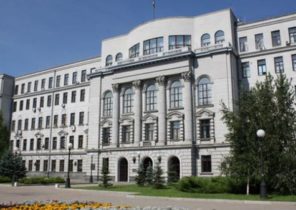Last weekend, after a decade of joint flights to the ISS with the Russian American space program resumed one of their cherished and iconic traditions: the launch of astronauts into space with their own land and their own missiles.
The event was widely celebrated as the beginning of a new era in space — there was talk of lunar colonies, trips to Mars, space tourism, interplanetary capitalism and cool new suits from “SpaceX”. “We are trying a new business model business model partnership between government and the private sector. Ultimately it will allow us to go to the moon, this time for a long time”, — said at a press conference on 26 may, the administrator of NASA Jim Breidenstein (Jim Bridenstine).
But these triumphant statements side by side on the front page of news more alarming how vulnerable we are here on Earth. A week before the launch, the number of deaths from the coronavirus in the United States exceeded 100,000, and the frustration caused by the pandemic — unexpected, and widespread unemployment and glaring social injustice — clearly spurred unrest that has erupted at the weekend, many American cities.
It’s hard not to see that the ominous signal from the universe in which some thinkers see the prediction of our fate as a species. In 1998, Robin Hanson (Robert Hanson), now a Professor of Economics at George Mason University, asked a vexing question: if the universe is really a flourishing garden of opportunity, according to astrobiologists and cosmologists, then why, among the billions of worlds for billions of light years was there no one who would have to greet us?
Where is alien Amateur radio operators with their transmission of scientific secrets or extraterrestrial recitations of poetry? Where did the mysterious engineering projects in interstellar space? Where is our invitation from the Galactic Council? Once asked the great physicist Enrico Fermi (Enrico Fermi): “Where is everyone?”
Maybe they absorbed the Great filter, suggested Dr. Hanson. Great filter — an event or circumstance civilizational scale, which does not allow one species to colonize outer space or to meet other types, although those are quite possibly exist.
The filter may be the chemical a bottleneck that prevents the formation of RNA, which began evolution, or geophysical obstacle to the emergence of oxygen, which is necessary for multicellular creatures. But the filter may be a nuclear war that destroys the world an asteroid, global warming or the evil artificial intelligence that went crazy. Maybe even savage pandemic.
“The fact that all the surrounding space appears to be dead, tells us that any given piece of dead matter has an astronomically low chance to engender life — written by Dr. Hanson. Thus, there is a great filter between death and a long continued life, and to humanity raises the ominous question: how far we are from this filter?”.
Can microbes destroy our space plans? Experts from Dr. Anthony Fauci (Anthony Fauci) to Tom Hanks (Tom Hanks) assure us that the current pandemic is not the End of the world, but not to see in it the dress rehearsal is impossible.
Martin Rees (Martin Rees), he is the Lord Rice of Ludlow, a cosmologist from the University of Cambridge and co-founder of the Center for the study of existential risk, describe in detail the options for our demise in the book “Our final hour or the warning from the scientist: how terror, negligence and environmental disaster threaten humankind’s future in this century — on Earth and beyond” (Our Final Hour: A Scientist’s Warning: How Terror, Error, and Environmental Disaster Threaten Humankind”s Future In This Century — On Earth and Beyond). When the coronavirus has just started to wreak havoc in China, I wrote to Dr. Rice by email, the email asked, it would be a Great filter.
“These global pandemic — an unsolvable problem,’ he replied. — It is obvious that the more we understand viruses, the more we can develop vaccines.” However, he added: “the Disadvantage is that this will be followed by the risk of the spread of the so-called “dangerous knowledge”, which the renegades will be able to make the viruses more virulent and transferable than they are in nature.”
The idea of Professor Rice and his colleagues is that we have outgrown ourselves, too wised up and overgrown with excess connections to his own detriment. As a result, we are approaching the most ominous term in the equation known American astronomer Frank Drake (Frank Drake) to estimate the number of technological civilizations in the galaxy: the average lifespan of a technological society.
How long can live a high-tech society? Regardless of the chances of the formation of planets and the origin of life, the more reasonable, if the emerging civilizations don’t live long, they will never overlap in time and space. Each civilization can flourish, and then disappear by itself, and not knowing neighbor. If this is not a recipe cosmic loneliness, I don’t even know what it is.
But even in this cloud of darkness there is a ray of hope. In a science fiction story by Arthur C. Clarke (Arthur Clark) “Sentinel” (The Sentinel) that formed the basis of the film by Stanley Kubrick (Stanley Kubrick) “2001: a space Odyssey” (2001: A Space Odyssey), a pair of astronauts discovers on top of a mountain on the moon a small pyramid. When they approach her, she sends alarm; astronauts are left to wonder whom the signal is intended and when are “they”.
We are still not enough studied our Solar system, to exclude the existence of such guards left by the aliens on Mars or another planet. Being sentenced enthusiasts search for extraterrestrial civilizations: “Absence of evidence is not proof of absence”.
We don’t know yet, some we like it or not. But I can find out, scattering their own relics throughout the Solar system. This year alone on Mars sent three more missions involving robots.
Dr. Rice in his recent post emphasized that perceptions of the distant future has evolved greatly since 1961, when Dr. Drake first presented his equation. In addition, an important factor was artificial intelligence, which then could only dream of. Neural networks and deep learning embedded in science, politics and society, and we have hardly begun to argue for what. They are the future.
“”Civilization” in the sense of collectively intelligent technologically advanced creatures, there may be only a few thousand years — wrote to me Dr. Rice. But their legacy can become a kind of “brain” that live a billion years.” And they can give deep thoughts that we do not understand.
“The search for extraterrestrial intelligence finds just such entity (unless, of course, he do anything will find)”, — he wrote.
That is, if humanity will survive itself and will continue to seek and explore. This is hardly guaranteed: we are all here briefly, including the virus.
Gnawing granite science all my life, I realized that nature is of no special handicap people in General and democracy in particular. (Dinosaurs in his own defense could well consider themselves navel of the universe, but now they are not, and to ask what they were, nobody). We themselves and rely on foreign assistance are unable.
But in spite of flawless mathematical rigor thinkers like Dr. Hanson and others, I have no hope that we will prevail. We flourished, but not yet vanished, at least for now. Think of it as a great cosmic reboot or a call to action.
In March, when the pandemic was closed by the Italian laboratory where the experiment with dark matter worked as a physics Professor from Princeton Galbiati Cristiano (Cristiano Galbiati), he and his family went to Milan.
There he found that the artificial lungs ventilation machines for the most difficult patients are sorely lacking, and they cost like a new car. Then Dr. Galbiati gathered a group of experts in particle physics to develop a simple, cheap ventilator with open source code that can be built anywhere. His colleagues enthusiastically supported him.
A month later their respirator Milano approved the American management under the control over products and medicines for use in emergency cases. And this is just one of the many simple of the ventilator, which appeared in University and industrial labs like mit, NASA and others.
“You know, I like to think that the virus is spreading, as they say, with the speed of jet aircraft,’ said Dr. Galbiati. But our research moves at the speed of light. And, you know, largely because of this I have no doubt that we will win.”
That’s why I think so: Mars or bust.
Dennis Overby works in the “new York times” since 1998. The author of two books: “Lonely hearts of the cosmos: the history of the scientific unraveling the mysteries of the Universe” (1991) and “Einstein in Love: a scientific romance” (2000).







